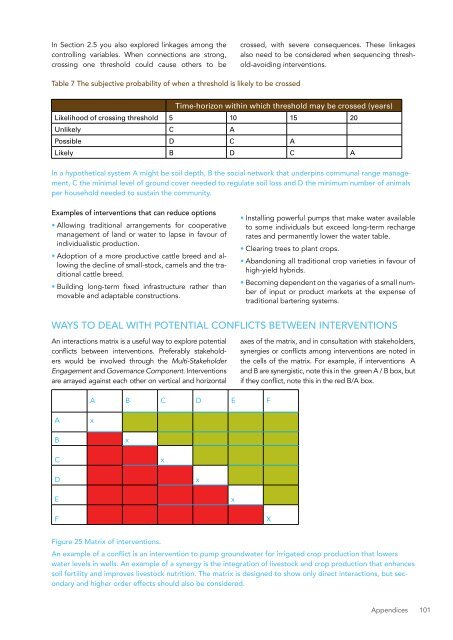DESIGNING PROJECTS IN A RAPIDLY CHANGING WORLD
srun3013fp1
srun3013fp1
You also want an ePaper? Increase the reach of your titles
YUMPU automatically turns print PDFs into web optimized ePapers that Google loves.
In Section 2.5 you also explored linkages among the<br />
controlling variables. When connections are strong,<br />
crossing one threshold could cause others to be<br />
crossed, with severe consequences. These linkages<br />
also need to be considered when sequencing threshold-avoiding<br />
interventions.<br />
Table 7 The subjective probability of when a threshold is likely to be crossed<br />
Time-horizon within which threshold may be crossed (years)<br />
Likelihood of crossing threshold 5 10 15 20<br />
Unlikely C A<br />
Possible D C A<br />
Likely B D C A<br />
In a hypothetical system A might be soil depth, B the social network that underpins communal range management,<br />
C the minimal level of ground cover needed to regulate soil loss and D the minimum number of animals<br />
per household needed to sustain the community.<br />
Examples of interventions that can reduce options<br />
• Allowing traditional arrangements for cooperative<br />
management of land or water to lapse in favour of<br />
individualistic production.<br />
• Adoption of a more productive cattle breed and allowing<br />
the decline of small-stock, camels and the traditional<br />
cattle breed.<br />
• Building long-term fixed infrastructure rather than<br />
movable and adaptable constructions.<br />
• Installing powerful pumps that make water available<br />
to some individuals but exceed long-term recharge<br />
rates and permanently lower the water table.<br />
• Clearing trees to plant crops.<br />
• Abandoning all traditional crop varieties in favour of<br />
high-yield hybrids.<br />
• Becoming dependent on the vagaries of a small number<br />
of input or product markets at the expense of<br />
traditional bartering systems.<br />
WAYS TO DEAL WITH POTENTIAL CONFLICTS BETWEEN <strong>IN</strong>TERVENTIONS<br />
An interactions matrix is a useful way to explore potential<br />
conflicts between interventions. Preferably stakeholders<br />
would be involved through the Multi-Stakeholder<br />
Engagement and Governance Component. Interventions<br />
are arrayed against each other on vertical and horizontal<br />
axes of the matrix, and in consultation with stakeholders,<br />
synergies or conflicts among interventions are noted in<br />
the cells of the matrix. For example, if interventions A<br />
and B are synergistic, note this in the green A / B box, but<br />
if they conflict, note this in the red B/A box.<br />
A B C D E F<br />
A<br />
x<br />
B<br />
x<br />
C<br />
x<br />
D<br />
x<br />
E<br />
x<br />
F<br />
X<br />
Figure 25 Matrix of interventions.<br />
An example of a conflict is an intervention to pump groundwater for irrigated crop production that lowers<br />
water levels in wells. An example of a synergy is the integration of livestock and crop production that enhances<br />
soil fertility and improves livestock nutrition. The matrix is designed to show only direct interactions, but secondary<br />
and higher order effects should also be considered.<br />
Appendices 101


